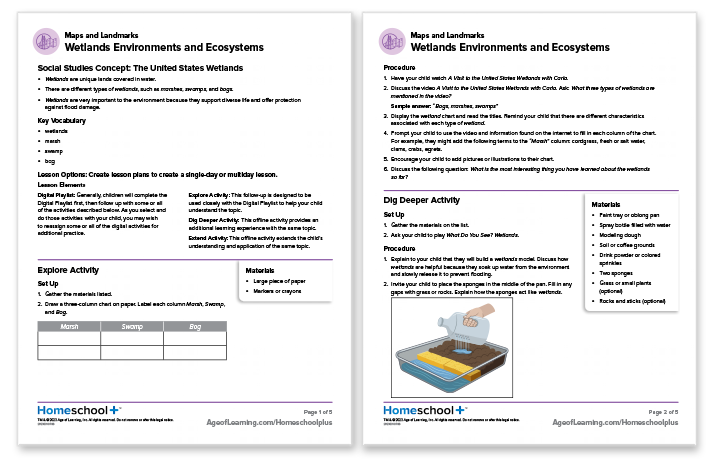COURSE
Maps & Landmarks
Maps & Landmarks will introduce your child to concepts including:
- How to Make Maps (Cartography)
- Relative Positions of Places & Physical Features (Geography)
- The Configuration of Physical Features of an Area (Topography)
- The Physical and Biological Aspects of Oceans and Seas (Oceanography)
- The Map’s Relationship to Actual Distances (Scale)
COURSE OVERVIEW
Help develop your child’s key critical thinking skills and inspire their creativity as you visit some of the most spectacular natural and man-made landmarks on Earth. Expand your child’s world through mapmaking, map painting, puzzles, world travel, exploration of America, iconic landmarks, and much more.
By the end of this course’s 12 lessons, your child will know the basics of mapmaking and how to read maps, as well as fundamental geographical concepts such as continents, oceans, and the 50 United States of America.
LESSON 1: INTRODUCTION TO MAPS
Help your child develop map skills that will last a lifetime as they learn about map keys, map features, how to use a compass rose, and much more. Together you will discover how maps are tools for learning about and exploring the world.
LESSON 2: UNITED STATES GEOGRAPHY
Give your child a basic understanding of the United States and its geography. This course includes lessons about the 50 states and covers the characteristics of the West, Midwest, Northeast, Southwest, and Southeast regions.
LESSON 3: EXPLORING AMERICA’S NATURAL WONDERS
Discover the diverse and beautiful natural landscapes that can be found throughout the United States. Through exploration of America’s National Parks such as the Grand Canyon and Yellowstone, you will share with your child the majesty of these natural wonders as you help build their understanding of stewardship and preservation.
LESSON 4: READING & CREATING PHYSICAL MAPS
Teach your child that a physical map provides information about the physical features of a particular region or place. Together, you will explore the features of Earth’s surface, including mountains, valleys, rivers, and oceans.
LESSON 5: THE GEOGRAPHICAL CHARACTERISTICS OF THE UNITED STATES
Through lessons on mountains, prairies, deserts, long rivers, and Great Lakes, this course is an opportunity to provide your child with a broad understanding of the physical features of the United States and foster their sense of curiosity and wonder about its diverse geography and landscapes.
LESSON 6: NOTABLE UNITED STATES LANDMARKS & BUILDINGS
Take your child on a tour of many of the most well-known and meaningful manmade and natural landmarks of the United States. As they progress, they will also learn more about the United States’ regions and states.
LESSON 7: WETLANDS ENVIRONMENTS & ECOSYSTEMS
Introduce your child to the important role wetlands play in the natural environment, the unique characteristics of swamps, marshes, and bogs, and the diverse array of species supported by those ecosystems.
LESSON 8: MAPPING THE LIBERTY BELL’S JOURNEY
This lesson invites your child to wear a patriot’s shoes as they follow the path of the Liberty Bell as it transforms from a simple town bell to an enduring symbol of American independence and liberty.
LESSON 9: PLANNING & NAVIGATING A ROAD TRIP
Help your child understand the basic principles of map reading and how to use maps to plan and navigate a trip through the experience of a road trip. Along the way, you’ll be giving them the skills to utilize key features such as the title, compass rose, and key to better understand the wealth of information included on a map.
LESSON 10: USING A GLOBE
In this course, you will teach your child to conceptualize planet Earth through the three-dimensional model of a globe.
LESSON 11: EARTH’S SEVEN CONTINENTS
In this lesson, your child will learn the names and locations of the seven continents, their differences, and their relationships to each other.
LESSON 12: MAP FEATURES: SCALES & GRIDS
Challenge your child to develop their spatial thinking skills as they learn to use the map scale, grid, and index to find and interpret information.
LESSON 13: DESERTS OF THE WORLD
Inspire your child with this fascinating lesson on some of the driest places on Earth! Your child will learn that deserts are places that get very little rain and that every continent around the world has one or more of them. Your child will also discover unique animals and plants that call deserts home.
LESSON 14: MOUNTAIN RANGES OF THE WORLD
Climb to new learning heights with your child as you teach them that the world’s continents have mountain ranges and that sometimes these ranges cross countries and states! Your child will also learn that a mountain range is a line of mountains connected by high ground and that altitude is how high up something is compared to sea level.
LESSON 15: RIVERS OF THE WORLD
Take a voyage of discovery with your child as they learn that the Amazon and Mississippi Rivers are two of the largest, longest rivers in the world and that other rivers flow into them. Your child will learn that the place where a river enters a lake, a larger river, or the ocean is called its mouth, and where a river starts is called its headwater.
